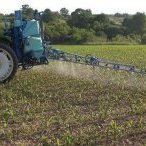English · Español

5 de febrero de 2018 | Testimonios | Agua | Soberanía Alimentaria
Uruguay: increasing legal complaints over crop damage and pollution of water sources with agrotoxics
Descargar: MP3 (3.2 MB)
In Canelones department, the region that concentrates a third of small-scale food farming, the number of environmental conflicts due to the use of agrotoxics has been growing exponentially. In addition to damaging commercial crops, agrotoxics have polluted sources of water for family consumption, and the powerful herbicide 2,4 D is to blame for the most serious cases.
In January 2017, seven families of "La Armonía" community, 34 kilometres away from Montevideo, the capital city of the country, lost all their vegetable crops when their irrigation water was polluted because of the activities of an agricultural company that used a herbicidal mix including picloram and 2,4 D.
2,4-dichlorophenoxyacetic acid is a highly toxic hormonal systemic herbicide developed during World War II and used in the arms industry as a defoliant.
Last year, the families have experienced serious discontinuities in their income and production, while the agricultural company, despite being disciplined by the National Environment Secretariat (Dinama) and the Agriculture Ministry, continues operating and applying chemicals that affect the inhabitants of the area.
The Committee against GM Soy in Canelones and in Defense of Water, an organization that submitted 12,000 signatures to the departmental government to ban said crop, held an assembly on January 26th, where they informed the population about what happened in 2017 and gathered testimonies of new problems in other areas of the department.
Real World Radio interviewed Diego De Amores, a young vegetable producer who is suffering water pollution caused by the runoff from nearby lands treated with herbicides with high biocidal power.
Diego lives and produces food products in Camino Mangangá, to the northeast of Canelones, on a three-hectare land, of which 3000 square meters are protected.
Two months after detecting the problem and suffer the total loss of the protected crops, Diego does not have the results of the tests that would allow him to know which herbicide caused the problem and therefore plan the recovery of the production cycle: "two months after samples were taken, we need to know the results of the tests and recover our production cycles, for us the clock is ticking", said Diego.
The regulation in force establishes a separation distance for the application of chemicals that takes into account "populated areas", but not isolated rural houses. "Currently, they are applying chemicals 30 meters away from the houses...I haven´t talked to the businessman in charge but they send me a WhatsApp message before applying the chemicals", said Diego.
The company declared having applied 2,4 D and gliphosate on an alfalfa crop, said De Amores.
In December 2017, new GM crops were authorized in Uruguay, including new soy variaties that are precisely resistant to 2,4 D and Dicamba. Therefore, people are concerned over the use of 2,4 D and its impact on water sources and food production lands.








